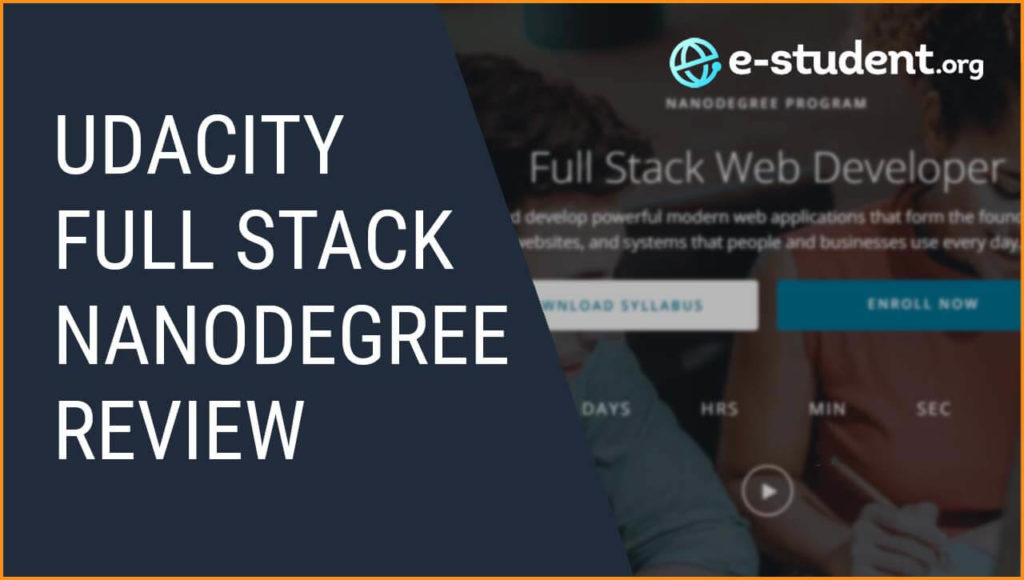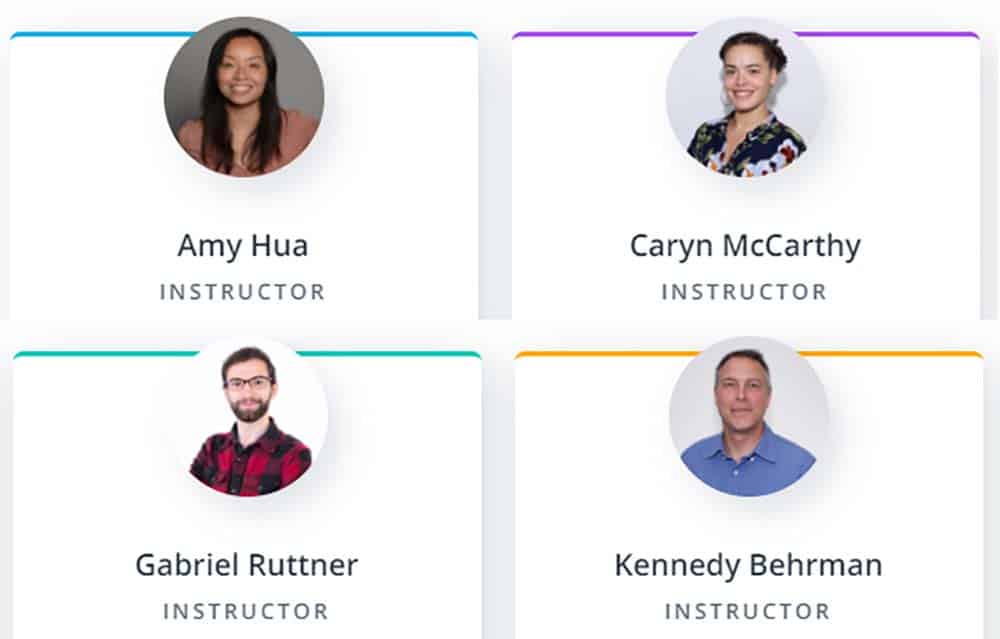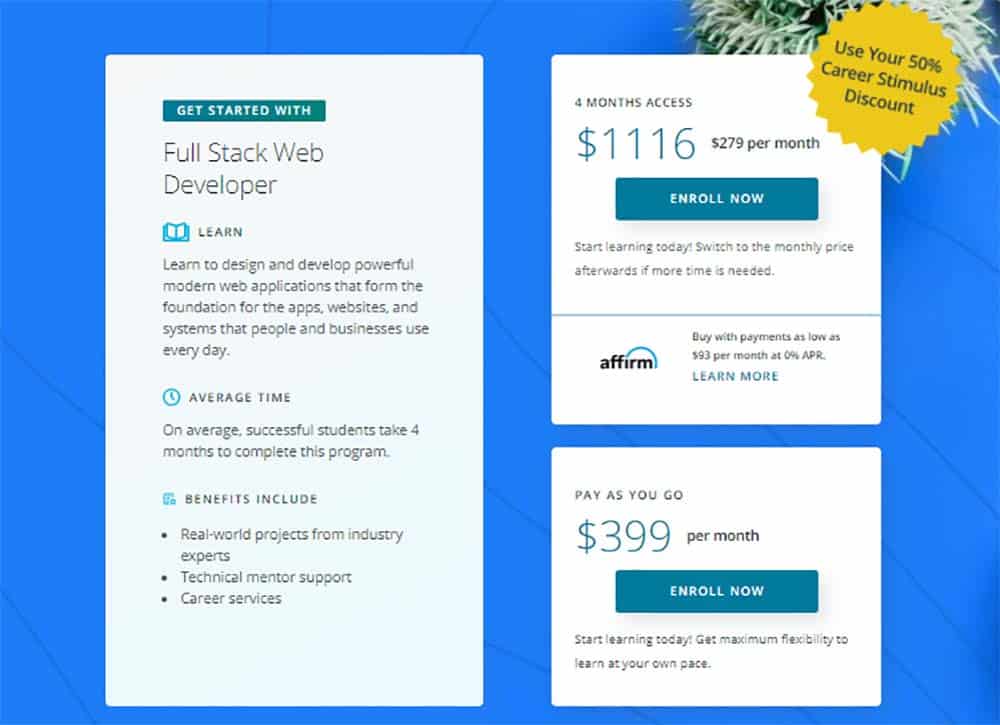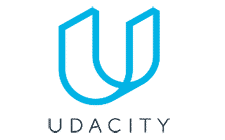
Full stack developers are familiar with all the layers of a development cycle. Often, they’re responsible for the end-to-end development of an application or website, handling servers, databases, and even clients. As Eric An at CareerFoundry aptly put it, “A full-stack developer has all the keys to the house — there is no door that you cannot open.”
If this sounds like a career path you’d be interested in, you may want to check out the Full Stack Web Developer Nanodegree available on Udacity. Originally launched in 2014, the Full Stack Web Developer Nanodegree was relaunched in 2019 to include the latest versions of tools and practices, brand new projects, and new instructors. But was this refresh necessary? And more importantly, is this Udacity Nanodegree any good? Let’s find out.
Table of Contents
Overview of the Udacity Full Stack Nanodegree
The Full Stack Web Developer Nanodegree on Udacity is a self-paced program designed to teach students how to build REST APIs and web applications through bite-sized video lessons, quizzes, and hands-on, real-world projects.
In addition to learning how to build databases for software applications and create database-backed web Application Programming Interfaces (APIs), students will also learn how to secure apps with user authentication and deploy them to the cloud.
Who is this Nanodegree for?
If you’re an intermediate Python developer looking to take your skills to the next level, this Nanodegree should be right up your street.
Similarly, data scientists who would like to be able to deploy their machine learning models in production will also find this Nanodegree useful. The same can be said if you work as a product manager and would like to strengthen your ability to communicate with the engineering team and get products out on time.
For web developers or front-end web developers who want to go full-stack, this Nanodegree is a good jumping-off point, as well.
What are the prerequisites of the Full Stack Nanodegree?
Udacity accepts just about everyone into its programs, regardless of their background or skill level. Nevertheless, to make the most of this course, students should have:
- Beginner-level experience in Python.
- Experience creating front-end websites using HTML, Javascript, and CSS.
- Knowledge of Github version control.
Ideally, you should also be familiar with object-oriented programming (OOP), while experience building server-side applications is also a plus.
How long does it take to complete the Udacity Full Stack Nanodegree?
According to the course description, students that put in between 5 and 10 hours of work each week can finish the program in about four months.
Realistically, though, the duration of the Full Stack Nanodegree will also depend on your coding skills, how seriously you take the various projects, and how much time you dedicated to each lesson.
If you breeze through the curriculum and fulfill only the minimum requirements you can easily finish the course in 2-3 months. But, if you want to take your time and soak up various sources of information while going through the syllabus, you’ll be looking at least at 4 months of learning. And, as you’ll be paying for 4 months of learning time, it definitely makes sense to take your time with absorbing the material.
Who are the instructors of the Full Stack Nanodegree?
The Full Stack Web Developer Nanodegree program on Udacity is taught by four instructors who are industry experts.

Amy Hua has almost 10 years of experience in data and tech. Working with companies like Socrata (responsible for delivering Obama’s Open Government Initiative) and Databricks (part of Apache Spark), she has designed data management systems, mapping tools for self-driving cars, and more.
Caryn McCarthy has worked as a software developer and software engineer as well as an experience manager at Google.
Gabriel Ruttner is an advisor for early-stage startups with experience in building cloud-based machine learning and natural language processing services. He is the co-founder and CTO of FeatherDocs, an enterprise SaaS company that automates document management.
Kennedy Behrman is a senior data engineer and a cloud solutions consultant to early-stage startups. He has co-authored Python for DevOps and is the co-founder of Pragmatic AI Labs, a company that provides content and training for educational brands, leading universities, and organizations like NASA and Microsoft.
How is the course structured?
Like most Udacity Nanodegrees, this Nanodegree is split into four courses which are further divided into lessons. Lessons are made up of videos, quizzes, and projects.
The videos are between 30 seconds and 3 minutes long, and go over the main concepts and best practices you need to know. Some of the video lessons also link to external resources where you can gain a deeper understanding of the topics covered.

In between video lessons, you get to fill out short quizzes, and at the end of each course, you have to complete a project. There are five projects in total: one at the end of each course and one capstone project.
Code reviews are an important part of the course. Each project is reviewed by experienced project reviewers who go through your code line by line and provide personalized feedback and useful tips on how you can make your code work more effectively. If you’re ever stuck on something, a team of technical mentors will answer your questions quickly.
What does the course curriculum contain?
This Udacity Nanodegree consists of four courses and five projects, including:
SQL and Data Modelling for the Web
Course one is divided into six lessons that aim to teach you how to query and manipulate relational databases with SQL and use Python to incorporate database logic into your programs.
Among other things, learning outcomes here include being able to:
- Build data models
- Create a lightweight data app using SQLAlchemy
- Get data from web forms using Flask
- Build a CRUD (Create, Read, Update, Delete) app
- Use Flask-Migrate and Alembic to modify a data schema
- Delete data from a database with SQLAlchemy
- Write complex queries on related data models
Project: Build the backend for an artist/venue booking application. Here, you’ll need to use programming languages and concepts like Python, SQL, SQLAlchemy, SQL migration, serialization, DB normalization, and Flask. Note that the lessons do not cover all of these concepts. As such, the learning curve for most people here is quite high.
API Development and Documentation
Course two consists of five lessons that will teach you how to use Application Programming Interfaces (API) for web applications.
Learning outcomes for this course include being able to:
- Explain APIs and HTTP
- Use cURL for HTTP requests
- Make a Flask endpoint
- Organize API endpoints
- Describe Cross-Origin Resource Sharing (CORS)
- Use testing software to test applications
- Perform Test-Driven Development (TDD)
- Write documentation for your API
Project: Build a REST API for a React front-end app.
Identity Access Management
Course three comprises five lessons that show you how to add authentication and authorization in Flask.
By the end of this course, you should be able to:
- Test APIs with the Postman application
- Add an application authentication layer with Auth0
- Secure your API with JSON Web Tokens (JWT)
- Add “salt” to passwords before hashing
- Use role-based access control (RBAC)
- Identify users and their permissions with JavaScript Web Tokens (JWT)
- Perform integration testing
Project: Secure a coffee shop application with role-based access control, using Auth0 as an identity provider.
Full Stack Server Deployment and Containerization
The final course of this Nanodegree consists of just two lessons that introduce you to container and virtual machine technology.
By the time you complete this course, you should be able to:
- Install Docker, a tool for building and sharing containerized apps
- Explain container orchestration
- Deploy a Kubernetes application
- Set up a Continuous Integration (CI) and Continuous Delivery (CD) with Amazon Web Services (AWS)
Project: Deploy an app on Amazon Elastic Kubernetes Service (EKS).
Capstone: The final project requires you to combine everything you’ve learned so far to build a database-backed web API with user access control.
How much does the Udacity Full Stack Nanodegree cost?
Udacity’s Full Stack Web Developer course has a two-part pricing plan: “4 Months Access” or “Pay As You Go.”
The “4 Months Access” plan, with Udacity’s 15% discount for upfront payments, is $1,356.60, which works out at $339.15 per month. On the other hand, the “Pay As You Go” option will set you back $399 a month. While you could try to save money by going for the monthly plan and completing a course faster, we’ve found that in general, the recommended number of months for the course are needed to properly complete the projects and make use of the mentor support.
The pricing is steep, but it’s still much cheaper than many other online coding bootcamps such as Thinkful. Comparing the price point to platforms for academic courses such as edX and Coursera, the price is higher, but the product offered by Udacity is quite different and a more suitable for many who are looking for a more practical approach to learning coding.

Pros of the Full Stack Nanodegree
As far as full stack web development programs go, this Udacity Nano degree has a lot of advantages. Here are some of them.
Real-world projects
This Nanodegree has five practical projects that require you to put to the test everything you’ve learned — and more.
Once you complete the course, the array of practical projects means that you should have a robust portfolio to present to potential employers. While theoretical knowledge is important, ultimately, your portfolio is what will give future employers a glimpse into the skills you’ve acquired.
Career services
Having a varied portfolio is great, but is your Github really the best it could be? Students enrolled in Udacity’s Full Stack Web Developer Nano degree will be able to take advantage of career projects like Github Review, Resume Review, and LinkedIn Review. These career services can help ensure that your job application stands out from the rest and lands you a coding interview.
Experienced instructors
The program is led by four industry leaders. Between them, they have decades of experience in web development — so you know you’re in good hands. All too often, online courses for developers are led by inexperienced beginners – thankfully that’s not the case with this Nanodegree.
Bite-sized lessons
As is the case with all Udacity courses, the lessons in this course are short and to the point.
In fact, because the lessons are just a few minutes long (at most), it makes it easier to find the time to study. Instead of having to dedicate a full evening to studying, you can learn a new concept or two during your lunch break.
Short completion time
The average student can expect to finish this course in about 4 months, as long as they put in around 10 hours a week. Of course, if you have a lot of spare time and are very focused, you can finish this program much faster.
Requires independent research
This may seem like a con to some, but the fact that students are encouraged to learn outside of the course material is actually a good thing. In fact, to complete most of the five projects that are part of this course, students have no choice but to do independent research.
Instead of giving you every tool to solve a problem, the instructors give you tools to figure out how to solve every problem, which is arguably the most important skill you can have in the real world.
Cons of the Full Stack Nanodegree
Few programs are perfect. Here are some of the areas where this Udacity Nanodegree falls short.
Focus on backend
The title of this Udacity course — “Full Stack Web Developer” — is somewhat misleading in that this program focuses mainly on backend development. All of the projects come with a premade front-end which means that you only ever need to fill out the back-end.
If you want to learn more about front end development, take a look at the Front End Web Developer Nano degree Program (and our review of it).
Expensive
At $1,356 for four months or $399 per month, Udacity’s web development course is not cheap. Note that Udacity has tweaked its prices several times over the past few years, most recently in 2022.
Some prerequisite knowledge required
This Udacity course has quite a few prerequisites, including proficiency in Python, HTML, Javascript, and CSS, making it unsuitable for total beginners.
Student Reviews of the Full Stack Nanodegree
Since the Full Stack Web Developer Nano degree was relaunched in 2019, many of the reviews left by past students on Class Central, Reddit, and Quora are no longer relevant.
Of the recent reviews that are available, most are positive, and those that aren’t tend to discuss price. For example, one reviewer on Class Central said, “Too expensive for what it has to offer. This is not intermediate level, but beginner level, the course revolves around Flask and provides information widely available for free.”
However, even though skeptics will always say that part, if not all, of the content can be found online for free, this course helps you wade through the massive amounts of information available, saving you a ton of time and providing you with guidance, expert-curated curriculum, and career support. All these things can go a long way in motivating you when you’re first starting out on your journey to becoming a full stack engineer.
It’s telling that when the Unitarian pastor and author John Pavlovitz asked, “Name a really good decision you made in your life?” on Twitter, one person replied with, “Paying for Udacity full stack web dev Nanodegree.”

Review Conclusion: does this Nanodegree help make graduates career-ready?
While Udacity’s Full Stack Web Developer Nanodegree program does not guarantee a job to anyone who completes the course, the program does point you in the right direction. The course curriculum is well thought out and easy to follow, a testament to the instructors’ ingenuity.
However, although the bite-sized video lessons are undoubtedly motivating, watching them will only get you so far. Indeed, it is the hands-on projects and, crucially, the constant encouragement from the instructors to do extra research that makes this Nanodegree worthwhile. Extra research is so important here that it almost feels like it should have been included in the course syllabus. To that end, don’t be surprised if some of the lessons end too soon, leaving you at the mercy of Google to complete the projects — this is intentional.
Ultimately, the strength of this Nanodegree lies not in its curriculum or even the certificate you get upon completing the program. Instead, it lies in the fact that this Nanodegree teaches students both the theoretical and practical components of working as a full stack web developer. And that is why this online course is a strong contender for the title of the best online full stack web developer courses.



